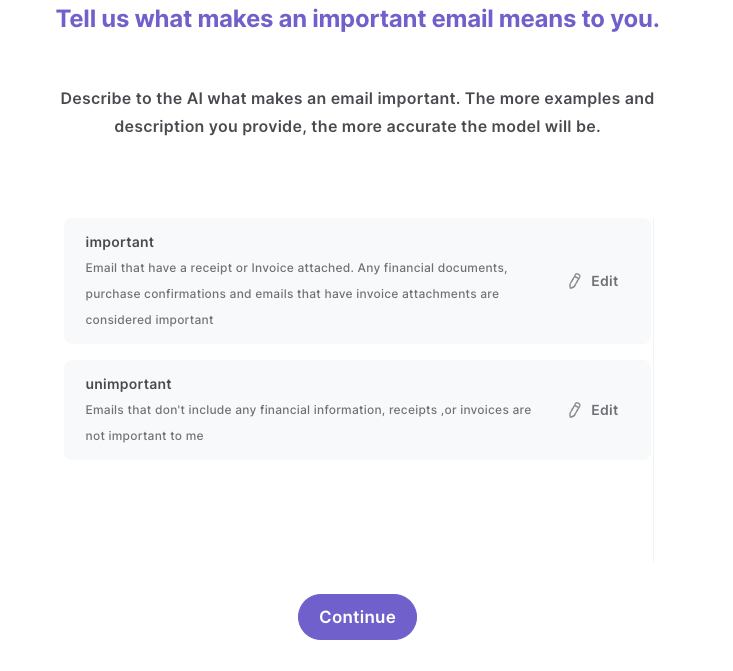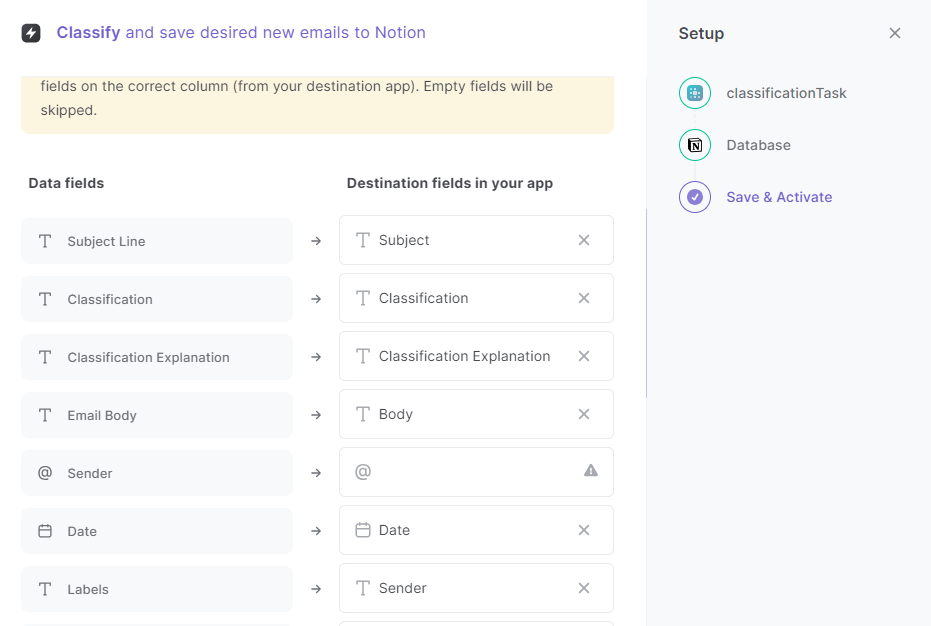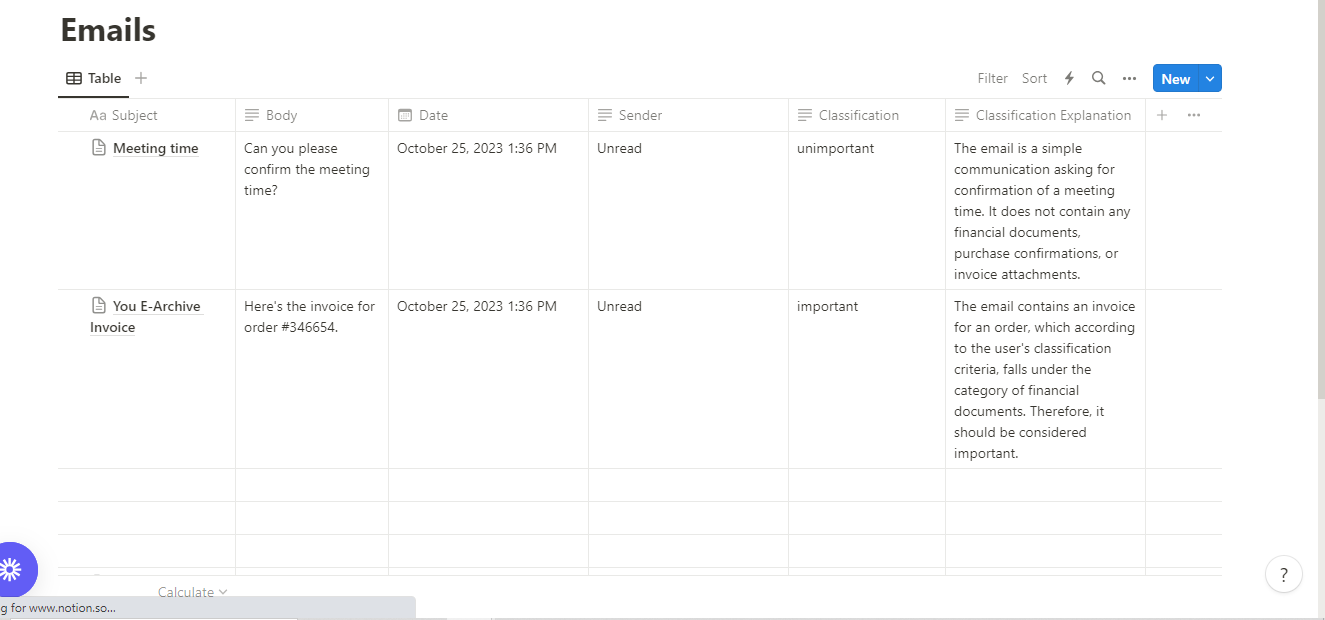Classify and save desired new emails to Notion
This is a Bardeen playbook. It's a pre-built automation template you can run in one-click to perform a repetitive task. Get started with our free Chrome extension.
Explore other automations
This playbook has been deprecated.
Explore Bardeen's playbook catalog for other automations or build your own.

How does this automation work?
Efficient email management is crucial for staying organized and ensuring important communications do not get lost in the shuffle. Bardeen's playbook for classifying and saving emails can automatically sort through your new emails, classifying them based on pre-defined criteria, and then seamlessly integrating them into your Notion workspace. Whether for research, sales prospecting, or personal productivity, having the right emails at your fingertips within Notion can be a game-changer.
Here's how this workflow classifies and saves emails to Notion:
- Step 1: Email classification setup - Receive new emails and use a custom BardeenAI classification task to determine their relevance and category based on your preset conditions.
- Step 2: Classify emails - The Bardeen AI Actions extension will classify the emails based on the text content you specify, streamlining your workflow to focus only on what matters.
- Step 3: Save to Notion - Important emails that have been classified as relevant will then be saved to a specified Notion database, creating an organized page for each email.
How to run the playbook
Navigating the flood of emails and attachments is like trying to find order in chaos, a struggle we're all too familiar with.
Enter our solution, designed to unravel the complexity of email management. This playbook goes beyond mere organization—it identifies emails with precision, gathering them into a structured Notion database. No more drowning in attachments or losing key information in the email abyss.
Whether you're steering project communications, conducting research, or simply craving inbox sanity, this automation is your streamlined ally. Bid farewell to email pandemonium and embrace a workflow that's both organized and efficient.
Let’s set it up!
Step 1: Create a Notion database
The first step is to create a Notion database with the email information you want to save.

Bardeen will extract information from your emails like subject, body, date, sender, classification, classification explanation and pair them with the information from your classifier, once your setup is complete.
Step 2: Install the extension and map the information to Notion
You will be redirected to install the browser extension when you run it for the first time. Bardeen will also prompt you to integrate Notion.
Click the “Pin it” button at the top of this page to get this automation saved to your Playbooks.
Activate Bardeen (or hit Option + B on Mac or ALT + B on PC on your keyboard) and click on the playbook card. The setup flow will start.
Bardeen will then prompt you to modify your email classifier. You can choose an existing one or create a new classifier with criteria for your emails.
After you click “customize classifier”, Bardeen’s classifier configuration will launch. You will be asked questions about your emails. Answer in as much detail as possible. This will ensure that the classifier is more accurate.

After you answer your questions, Bardeen will request that you sort your emails into categories. Your emails will be classified as “important” and “unimportant” based on your descriptions here. For example, I entered “Emails with Invoice” for the important emails and added details. Emails that fit that description will be categorized as “important” and any other emails will be categorized as “unimportant”.

Finally, we recommend that you train your classifier with sample emails to increase accuracy of the results.

After your classifier setup is complete and you choose your Notion database, Bardeen will ask you to map your fields to Notion.

The left side consists of all the fields Bardeen will scrape for you. On the right side, specify the fields in Notion that you want to associate with the information on the left. If you don’t want a piece of information, leave that field empty, and it will be skipped. That’s it!
Click on “Save Input” and checkmark Notion. You can edit Inputs later by hovering over the playbook.
Step 3: Run the playbook to classify and save desired emails to Notion
Press Option + B on Mac or ALT + B on PC on your keyboard to launch Bardeen. Click on the playbook card and run the playbook to classify and save your email. It will classify all newly received emails based on your classifier. It will then save the important emails to a Notion database.

You can also edit the playbook and add your next action to further customize the automation.
Find more Gmail and Notion integrations.
You can also find more about how to increase your personal productivity and automate your data sourcing and research workflow.
Your proactive teammate — doing the busywork to save you time
.svg)
Integrate your apps and websites
Use data and events in one app to automate another. Bardeen supports an increasing library of powerful integrations.
.svg)
Perform tasks & actions
Bardeen completes tasks in apps and websites you use for work, so you don't have to - filling forms, sending messages, or even crafting detailed reports.
.svg)
Combine it all to create workflows
Workflows are a series of actions triggered by you or a change in a connected app. They automate repetitive tasks you normally perform manually - saving you time.
FAQs
You can create a Bardeen Playbook to scrape data from a website and then send that data as an email attachment.
Unfortunately, Bardeen is not able to download videos to your computer.
Exporting data (ex: scraped data or app data) from Bardeen to Google Sheets is possible with our action to “Add Rows to Google Sheets”.
There isn't a specific AI use case available for automatically recording and summarizing meetings at the moment
Please follow the following steps to edit an action in a Playbook or Autobook.
Cases like this require you to scrape the links to the sections and use the background scraper to get details from every section.









